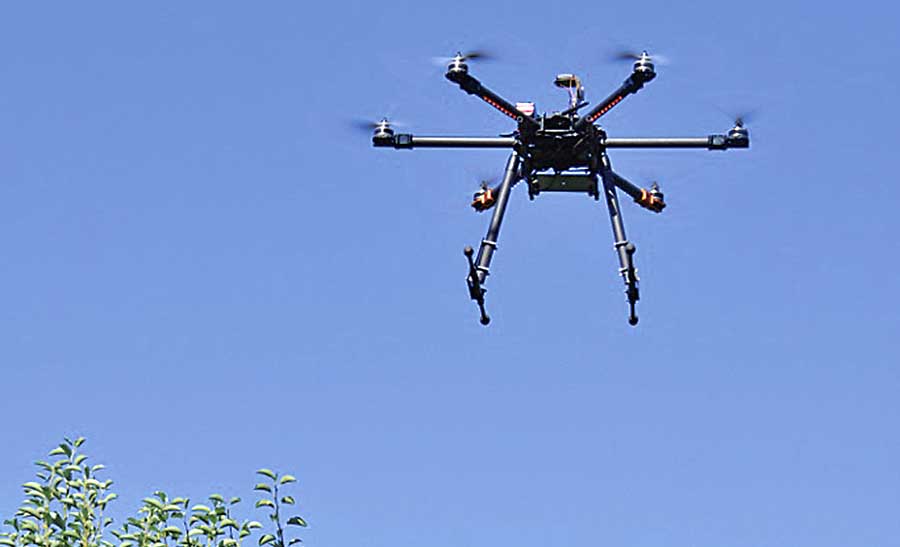
Drones have many potential uses in tree fruit production. The industry needs to be involved in the debates. (Courtesy Allison P. Fashing)
By Bruce Prenguber, Desmond O’ Rourke
Unmanned Aerial Vehicles, more popularly known as drones, have the potential to provide the fruit industry with new tools to improve its efficiency and competitiveness. However, federal rules that will govern all commercial use of drones are in the process of being written. Several states are also considering their own regulations and, here, too, the industry needs to engage in the dialogue.
Drones were developed originally for military use for flying over hostile territory without a human pilot while providing continuous pictures, in real time, to an observer in a secure location.
They have also been used to shoot down selected human and military targets. Drones designed for military purposes are highly sophisticated and expensive.
However, for many years, small companies and amateurs have been designing cheaper drones that can fly unmanned over any terrain and send back continuous, real time photographs to the operator. Farmers can fly their own drones, but only for private use. Drones have been used to scan potato fields, help fight wildfires, and for artistic aerial photography.
The range of uses is limited only by the operator’s imagination, the sophistication of the cameras used, and the length of time the drone can stay airborne. However, numerous safety and privacy concerns arising from their proliferation have led to demands for regulation.
Potential uses
Drones could be used by orchardists, nurseries, scouting programs, and areawide pest management programs to oversee new plantings, monitor trees and fruit development throughout the growing season, and track the progress of insect infestations, diseases, and spray efficacy, etc.
More sophisticated drones could selectively spray trouble spots before an infection can spread. During periods of extreme cold or heat, they could be used to monitor temperature and humidity in different air layers above the orchard. At harvest time, information on crop loads could be used to optimize size and placement of picking crews and support equipment, etc.
However, because drones can deliver massive amounts of photographic data in a short time, a major challenge will be to interpret that data and turn it into actionable information.
Orchardists will need machines that can read and geo-reference the data and stitch photographs together. They will need to match aerial images with ground-level knowledge of weeds, pests, and diseases. Engineering skills will be needed to turn drones into practical spray devices.
The expertise of tree fruit researchers, extension educators, field horticulturists, and scouts, etc., will be needed to interpret the mass of data. The Federal Aviation Administration may also require drones with enhanced flight capability or larger in size to be operated by certified “pilots.”
Orchard managers will need training to exploit the new data sources most effectively. While larger operators will want to hire and train their own drone managers, there will be opportunities for specialist drone firms to service groups of smaller growers.
One obvious problem for the fruit industry is how much the leaf canopy during the growing season will reduce the effectiveness of aerial surveillance. Another big issue will be which fruit will gain most from drone technology. Will it be more cost effective for a high-value, short-season crop like sweet cherries, or for lower-value, longer–season crops like apples and pears?
Finally, how can it be seamlessly incorporated into present management practices? Further detailed technical and economic analyses will be needed to answer those questions.
Federal regulation
The FAA claims jurisdiction over drones but does not currently permit commercial use. Congress requires it to have regulations on commercial use in place by the end of 2015.
In the meantime, many parties are challenging the FAA’s jurisdiction over drones, numerous commercial trials are ongoing, either through legal exemptions or in defiance of the FAA, and permits have been granted (rather haphazardly) to some universities to conduct various trials.
In setting technical standards for commercial drones, the FAA will have to resolve conflicts between long-established military suppliers and many, small, innovative entrepreneurs.
Its decisions on the altitude at which drones can be operated, or how close they can come to airports, power plants, or other sensitive sites, will also have a major impact on potential users. For example, many large orchards are located near regional airports. Protecting privacy and assuring safety will be critical. There will be tough battles ahead on all these issues.
While final FAA and state regulations on commercial use of drones may be many months off, the political battles are already far advanced. The fruit industry needs to get involved to ensure that eventual regulations make drone use practical and -economical for tree fruits.
Contact Bruce Prenguber at bruce@globalwiseinc.com or
Desmond O’Rourke at belrose@pullman.com.






Leave A Comment